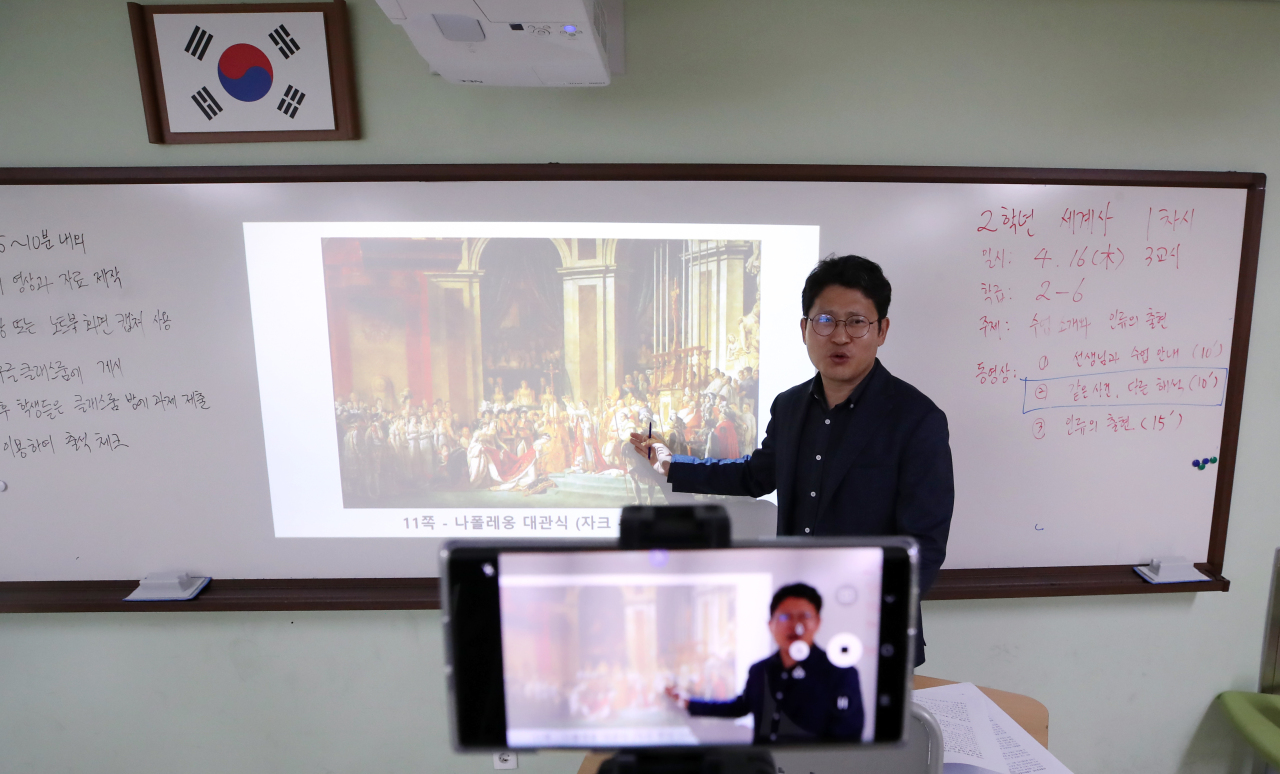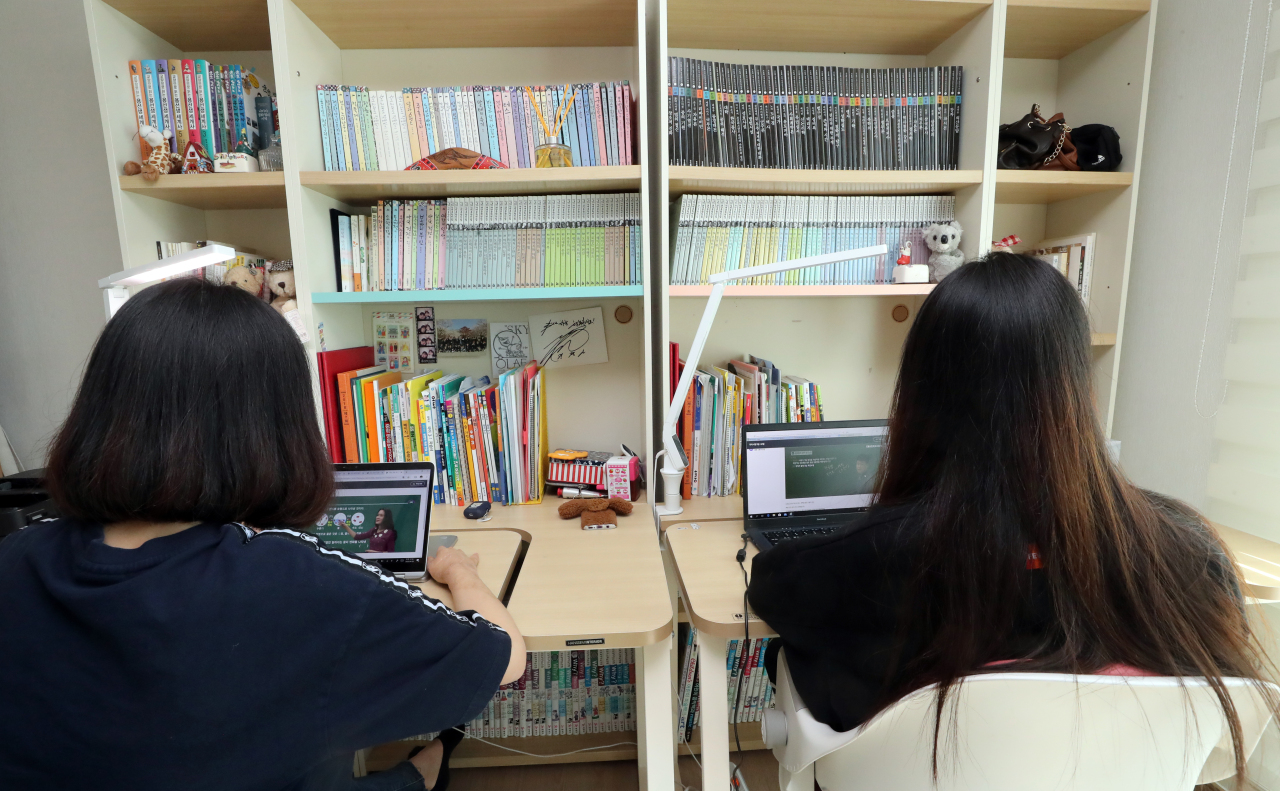 |
(Yonhap) |
A sense of excitement and anxiety was missing from the classroom on the first day of the new spring semester.
Middle school English teacher Yoon Suk-joon, 58, was all alone as lessons began, with no students around. He greeted his students in a virtual classroom, with a laptop, headset and projector.
As the semester’s first class began for ninth graders in Soongmoon Middle School at 11 a.m., some 45 students clicked on a link via Google Classroom, a service that offers online learning tools on the web or through an app, to check in for a 45-minute interactive live class.
Yoon’s laptop screen was busy with online study material, English textbook pages he was showing to his students through a projector and screens of his students showing their faces via video-streaming software Zoom.
“Please type in what the lion should have said in English in this situation in the chatroom,” Yoon told his students, showing a picture. Soon, the chatroom was flooded with students typing in answers.
Korea began its new spring semester Thursday, one month later than usual, with online classes as the country continues its fight against COVID-19. Schools remain physically closed.
Distance learning is not without challenges, even for Korea, one of the world’s most wired countries.
Educators are inexperienced in holding classes online, and smart devices and internet connections are not equally available for all schools and students. Neither can all parents afford to supervise their children taking online classes at home.
Concerns also persist over technical problems stemming from overloaded traffic to e-learning websites as well as quality of classes varying based on how prepared teachers and schools are.
The EBS Online Class for middle school students experienced a server problem for about an hour and 15 minutes on Thursday, according to the Education Ministry.
 |
(Yonhap) |
“I thought online classes were similar to offline classes, but there were some inconveniences in logging on to the system,” said Choi Min-ki, a student in his final year at a middle school in Incheon.
He watched video content already available on YouTube on the history of infectious diseases, preventing school violence, digital sex crimes, with his teacher checking whether students watching the videos through a KakaoTalk chat room.
Under the Ministry of Education’s guidelines, teachers at their own discretion can choose the most optimal method of teaching for students.
Like Yoon, educators can hold real-time classes using interactive livestreaming services such as Zoom. They can opt for pre-recorded materials readily available or prepared by themselves and uploaded on an online platform such as Google Classroom or EBS Online Class. Or they can just use material on educational broadcasting channel EBS and give students assignments.
Most schools, however, are likely to rely on one-way online classes, uploading study material and making students watch it.
“About the content and curriculum (in holding online classes,) I think I could get used to it. It is easy enough to use even for older teachers,” said Yoon, who has been teaching for 30 years. “The biggest problem, though, is that I cannot take care of students who lack motivation and need care.”
It also takes twice as long as usual for teachers to prepare a class -- especially when teachers opt to record the lecture and upload it.
“I put a lot of mathematical formulas in the presentation slides, so it took me five hours to prepare for the class, record, edit upload it,” said Namgung Seung-ho, 33, who teaches math at Soongmoon Middle School. It usually takes two hours for him to prepare a 45-minute class.
“For teachers, it is easy to hold classes offline and interact with students in person.”
The reopening of the country’s elementary, middle and high schools, originally scheduled for March 2, has been pushed back four times amid concerns that enclosed, packed classrooms could host new clusters of infections.
Online learning began first for middle and high school students in their third and final year on Thursday. Classes will begin on April 16 for first- and second-year students at middle and high schools, and elementary school students in the fourth to sixth grades. The rest -- first to third graders -- will start to receive remote learning on April 20.
Students could start going to physical schools as early as the end of April, taking turns by grade or holding classes on different timetables to ensure safe social distancing between students, according to Education Minister Yoo Eun-hae.
As the class nearly came to an end, teacher Yoon clicked on the students’ names in turn so he could see their faces large on the screen, telling them goodbye until the next time they see each other again, albeit virtually.
“I miss you guys, I really do,” Yoon told his class.
It is a completely new way of learning -- a way that could be a new norm for coming years and that provides an opportunity for the country’s education to develop in terms of its content and structure, he said.
By Ock Hyun-ju (
laeticia.ock@heraldcorp.com)









![[Today’s K-pop] Blackpink’s Jennie, Lisa invited to Coachella as solo acts](http://res.heraldm.com/phpwas/restmb_idxmake.php?idx=644&simg=/content/image/2024/11/21/20241121050099_0.jpg)